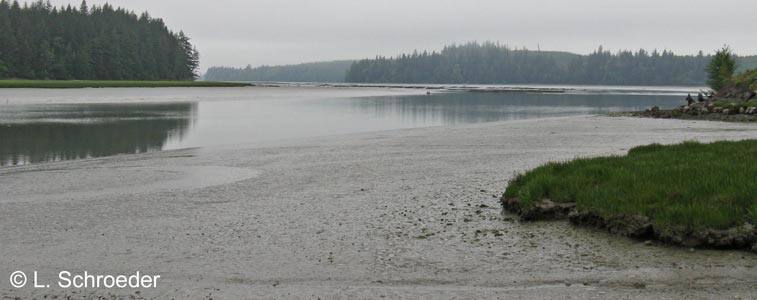Willapa Bay to Cape Disappointment
Pacific Co., WA
Site Description:
Willapa Bay is at the southwest corner of Washington. The bay is mostly mud or mud/sand beaches due to the many rivers draining silt into the bay. There are few areas with rocks. There is much oyster culture in the bay and this has resulted in a number of introduced species in the area. Our site covers an oyster bed and a mud flat with adjacentmud bank containing boring species.
Cape Disappointment is at the far southwest corner of Washington and it has shoreline facing both the Pacific ocean and the Columbia River. The ocean beaches are typical sand beaches. There is a large breakwater at the southern point. The shoreline facing the river is more mixed, with rocky headlands, sand, and mud/sand beaches. Our ocean beach site covers the area from Cape Disappointment to Long Beach.
Google Map

Willapa Bay


Cape Disappointment - west to Pacific Ocean
- south to Columbia River
Species List:
Following is a list of mollusk species observed at this location by members and associates of the club. This is by no means a complete list of the species which may occur at this site. Revisions and additions to the data are made as we acquire new information. When a site contains more than one very distinctive type of habitat or if multiple sites were included in a single location, then a species list for each is included.
We indicate frequency of occurrence based on our observations. This is an indicator of how likely it is that you may be able to find this species yourself and is not a formal population survey.
Frequency Code: (Based on the assumption that you are looking in the appropriate location where the species
likes to live - on rocks, in sand, etc. Some populations fluctuate seasonally. Ours are based
on the spring/summer seasons.)
[4] - Rare - very difficult to find, maybe only a couple found after repeated visits to the site
[3] - Uncommon - difficult to find, may not see on every trip but dedicated searching may turn up a few
[2] - Common - easy to find, should locate a number of them on any given day
[1] - Abundant - very easy to find, large numbers should be seen on every trip
Data is all intertidal unless noted.
This is only a sampling of data from this area and is very incomplete. Due to the nature of the data, only the Willapa Bay site will be rated for frequency. The frequency and species will vary in different parts of the bay.